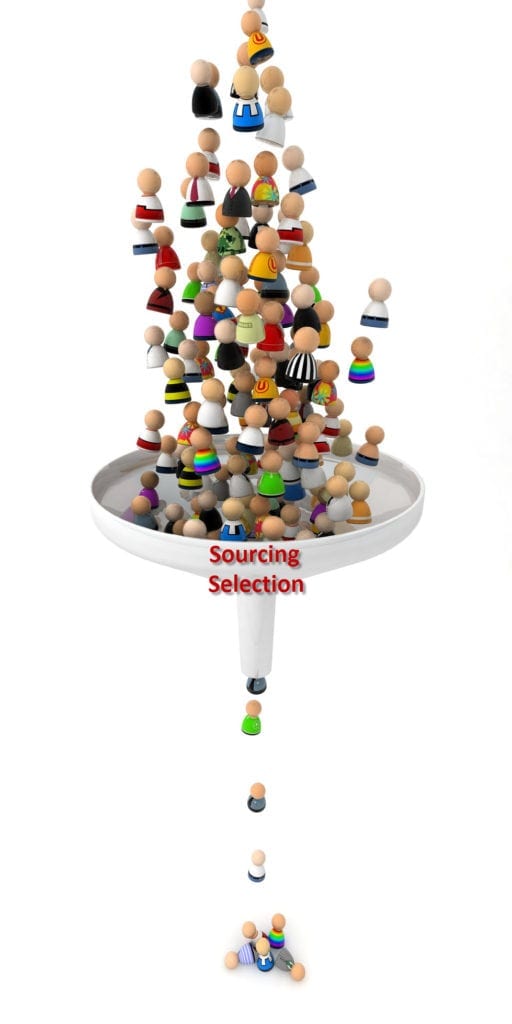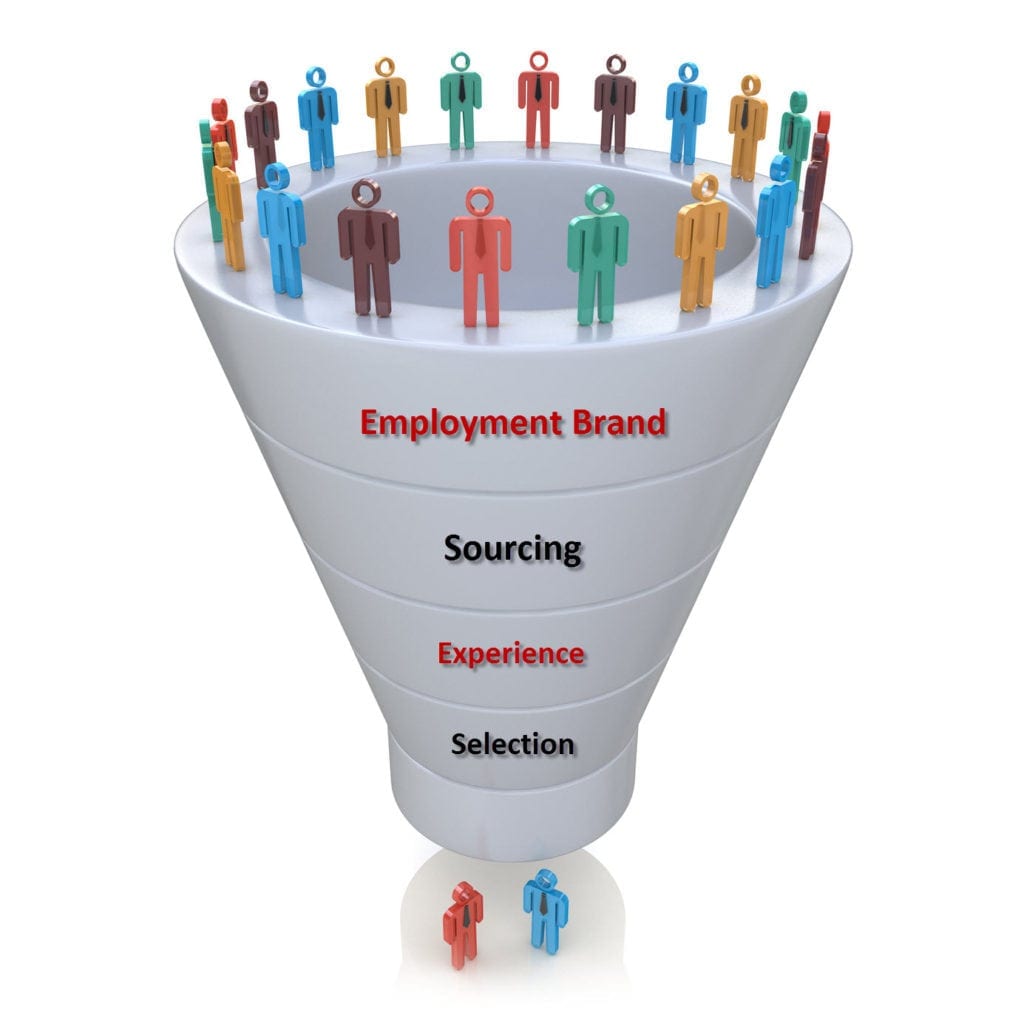It’s tough to find the right talent these days. Blame it on your recruiting funnel.
Many companies find they have more jobs to fill for a variety of reasons – turnover, retirement, and growth. Nearly half of employers report they are having difficulty filling positions with internal candidates due to a growing skill shortage. Time to fill jobs has increased steadily since 2010. Employers estimate that on average, they lose more than $14,000 for every job that stays vacant for 3 months or longer.
What’s the problem?
It begins with the new hiring process. Many companies still recruit like it is business as usual…in the 1960s when Baby Boomers flooded the market and many good paying jobs required more brawn than brain. But fast forward to 2016 and the labor, consumer, and economic landscape is vastly different. Old strategies just aren’t working. Shifting demographics, technology, and the demand for predictive analytics have disrupted the world of recruiting. You need a new hiring process and an updated recruiting funnel.
 Up until a few years ago the recruiting funnel consisted of 2 elements- the upper cone and a narrow stem. Sourcing candidates filled the cone and after completing a simple application and quick interview, many employees were hired. Companies filled the cone by publicizing job openings in classified ads and word of mouth. Since job skill requirements were lower (stem was wider) and labor was abundant (endless source of candidates to fill the cone), it worked.
Up until a few years ago the recruiting funnel consisted of 2 elements- the upper cone and a narrow stem. Sourcing candidates filled the cone and after completing a simple application and quick interview, many employees were hired. Companies filled the cone by publicizing job openings in classified ads and word of mouth. Since job skill requirements were lower (stem was wider) and labor was abundant (endless source of candidates to fill the cone), it worked.
But then the SHIFT hit the plan. Global competition, exponential technological change, economic volatility, and aging demographics converged. Companies reengineered and even reinvented themselves. They needed fewer but smarter and more skilled workers. And yet they continued to use the same old 2 stage recruiting funnel – source and hire.
The problem is employers feel they are in control. It’s time to wake up to the new hiring process. Just like the consumer market, talent is now behind the wheel. Job candidates, particularly the skilled and in-demand ones, demand more.
So it’s time to see what the new hiring process looks like standing in the shoes of top talent.
These jobseekers added two more layers to the recruiting funnel – employment branding and candidate experience. Here is what the new recruiting funnel looks like.

Employment Branding
The message shown in this recruitment funnel is loud and clear: “we’re not applying simply because you have an opening. We want to know what it’s like to work for you and how you treat your employees, your customers, the community, the environment.” In other words, before a company can get the attention of top talent, it has to get its messaging just right. In the new hiring process, offering a paycheck with benefits is no longer enough.
In LinkedIn’s Talent Trends Report, 56 percent listed employment brand as the most important factor in considering a new job. It’s simple – in the new hiring process, reputation matters most. Social media took branding out of the hands of management and placed it at the feet of the candidate. They can just as easily kick a company to the side as pick you up to play the game. Providing a positive culture, vision, values, and purpose are just as important to the new hiring process as pay and benefits.
Sourcing
Stage 2 of the hiring funnel is sourcing. Sourcing is not advertising. It’s relationship building. Developing a healthy pipeline of talent requires a continuous 24/7, dynamic approach. Sourcing has no off switch. Technology has put the rolodesk on steroids. Multiple candidate streams are essential. Job boards are still viable, especially job aggregators like Indeed, but the broadcast approach to announcing a job opening is essential, at least until you have the data to identify sources that work. Using spreadsheets to manage sourcing is like running in high heels in an Olympic 100m sprint. Social recruiting is growing fast too. Social media, referrals, and past candidates are increasingly important sources of talent. To fill open positions on-demand requires engagement with both active and passive candidates.
Candidate Experience
Welcome to Stage 3 of the recruiting funnel – candidate experience. It’s likely the one that is demanded most by candidates and ignored by companies. Job seekers now demand a consumer-level experience; a similar interaction to one they receive when shopping at Amazon and Zappos. The problem begins with the application. Forty-four percent of applicants will abandon the application if it looks outdated. Application rates drop by 365 percent if the application takes more than 15 minutes to complete.
Often times the new hiring process begins before an applicant gets the urge to look. Nearly half of all job seekers and 86% of Millennials start a job search on a smartphone or table and yet only a fraction of organizations have responsive website design for their career page…and even fewer have optimized applications.
The next pet peeve is what I call ghosting – or the failure to communicate quickly and nurture job candidates. Ghosting is a significant reason for abandonment during the process. “Due to the volume of applications we receive” is a lame excuse. While not ideal, a personal crafted series of messages can easily be sent to candidates to keep them updated on their status. And for goodness sake, extend the courtesy to reply promptly to phone calls and emails!
Candidate experience matters. It’s now more important than ever to create meaningful relationships with all applicants. So before you ignore a candidate or sent a curt email, recognize that 51 percent share a good hiring experience on social media and 34 percent share a bad one. Be respectful and friendly. Treat each candidate as a lead because they are.
Employee Selection
The days of resume, cover letter, and interview are over. Making hiring decisions based on gut instinct or because they attended the right school or have “x” years of experience is bogus. In case you missed the memo, resume writing is a career and jobseekers are often better prepared for interviews than hiring managers and recruiters. Successful employee selection requires objective data which is one reason the use of pre-employment testing and predictive analytics is skyrocketing. Social media profiles also provide a trove of information. Hiring right has become part art and part science. And as more slack comes out of the labor market, data will become a differentiator between winners and losers in the war for talent.
It’s time to dump the 2-stage recruiting funnel and embrace the bigger, newer, and better process of employment branding, sourcing, candidate experience, and employee selection.
